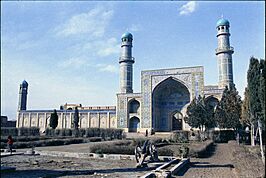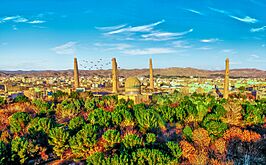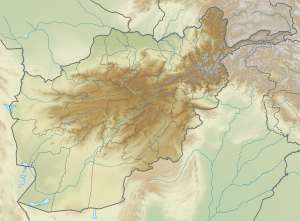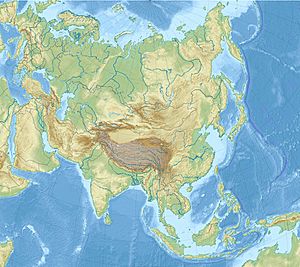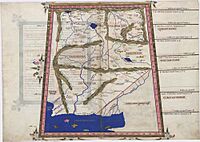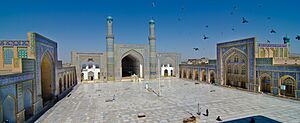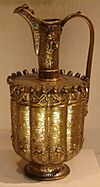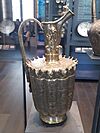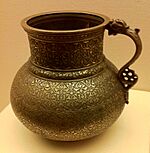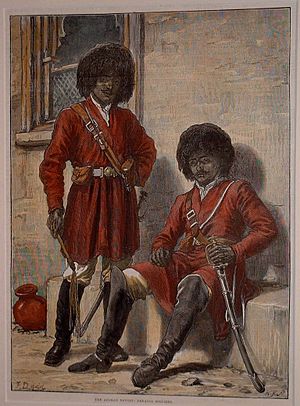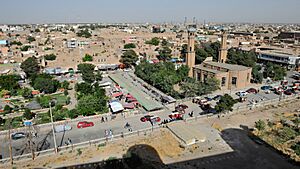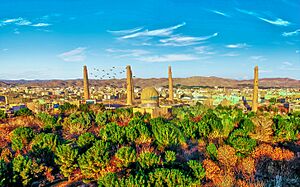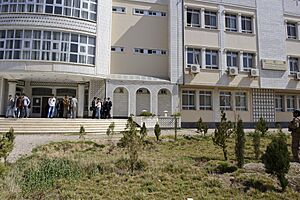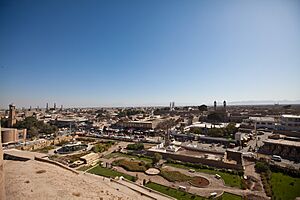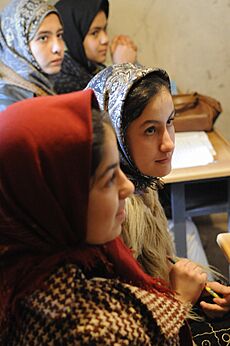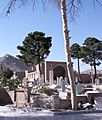Herat facts for kids
Quick facts for kids
Herat
ولایت هرات
|
|
|---|---|
|
Left-to-right from top:
Great Mosque of Herat, Herat Citadel, Herat University, panoramic view of Musalla complex, Jama Mosque exterior, skyline of Herat city |
|
| Nickname(s):
"The Pearl of Khorasan"
|
|
| Country | |
| Province | Herat |
| Area | |
| • Total | 182 km2 (70 sq mi) |
| Elevation | 920 m (3,020 ft) |
| Population | |
| • Estimate
(2021)
|
592,902 |
| Time zone | UTC+4:30 (Afghanistan Standard Time) |
| Postal code |
30XX
|
| Climate | BSk |
Herat (/hɛˈrɑːt/; Pashto, Persian هرات) is an oasis city in Afghanistan. It is the third-largest city in the country. In 2020, about 574,276 people lived there. Herat is the capital of Herat Province. It is located in a fertile valley near the Hari River.
Herat is a very old city. It was once an important stop on the famous Silk Road. This ancient trade route connected West Asia, Central Asia, and South Asia. Herat was known for its wine a long time ago. The city has many historic places, like the Herat Citadel and the Musalla Complex.
During the Middle Ages, Herat was called the Pearl of Khorasan. After Tamerlane conquered it, the city became a major center for thinkers and artists. Under Shah Rukh, it was the heart of the Timurid Renaissance. This period was as important for culture as the Italian Renaissance was for Florence.
Since the 1700s, different Afghan rulers have governed Herat. In 1716, the local Afghans created their own Sultanate. Later, in 1747, Herat became part of Afghanistan. It was an independent city for some time in the 1800s. It joined Afghanistan fully in 1863.
Today, roads from Herat to Iran and Turkmenistan are still very important for trade. The city also has an international airport. In 2021, Herat was taken by Taliban fighters. The city might soon become a UNESCO World Heritage Site.
Contents
History
Ancient Times
Herat is a very old city, but no one knows exactly when it was founded. Under the Achaemenid Empire (550–330 BC), the area was called Haraiva. In old writings, it was known as Areia or Aria. The name comes from the local Herey River. This river flows through the area.
Herodotus, an ancient historian, called Herat "the bread-basket of Central Asia." This means it was a very fertile and important farming area. In 330 BC, Alexander the Great captured the main city of Aria, called Artacoana. He rebuilt the town and built a strong fort.
Herat was mostly a Zoroastrian city. It became part of the Parthian Empire in 167 BC. Later, it was part of the Sasanian Empire. Around 430 AD, Herat also had a Christian community. They even had a bishop. Herat was very important for its location. It was often involved in wars between empires.
Becoming Islamic
In the mid-600s, Arab armies came to the region. Herat was one of the main cities of the Sasanian Empire. The city likely surrendered to the Arabs. But like many places, Herat rebelled and had to be conquered again several times.
The Tang dynasty of China also had some control over Herat around 659–661 AD. This was the furthest west Chinese power ever reached. But this control did not last long. Local tribes soon drove the Chinese out.
In 870 AD, Ya'qub-i Laith Saffari conquered Herat. He was a local ruler from the Saffarid dynasty. He brought the religion of Islam to the area.
The Pearl of Khorasan
Herat was a major trading center. It was located on important routes from the Mediterranean Sea to India and China. The city was famous for its textiles during the Abbasid Caliphate. Many geographers wrote about Herat in the 10th century. They described it as a rich town with strong walls and plenty of water.
Herat was ruled by different dynasties. These included the Taherids and then the Saffarids. Later, the Sāmānid dynasty took control for about 100 years. In 998, Sultan Maḥmud of Ghazni took over Herat.

In 1040, the Seljuk Empire captured Herat. The city grew a lot under the Ghurid dynasty in the 12th century. One writer said Herat had "359 colleges, 12,000 shops, and 6,000 bath-houses." The great mosque of Herāt was built in 1201. Herat also became known for making metal goods, especially bronze.
Mongol Invasion and Timurid Golden Age
The Mongols attacked Herat twice. The first time, the city surrendered. The second time, there was a rebellion. The Mongols besieged the city for seven months. After they won, many people were killed. The city was left in ruins for many years.
In 1244, a local prince named Shams al-Din Kart became the ruler of Herat. His family built many mosques and other buildings. They also supported writers and artists. Herat became known as the pearl of Khorasan again.
Timur took Herat in 1380. The city reached its greatest glory under the Timurid princes. This was especially true under Husayn Bayqarah, who ruled from 1469 to 1506. His chief minister, Ali-Shir Nava'i, was a great builder and supporter of the arts. Herat became the capital of the Timurid empire. It was famous for its beautiful buildings, music, and miniature paintings. This was a time of peace, wealth, and cultural growth. Many famous buildings, like the Musallah Complex, were built then.
In 1507, the Uzbeks took Herat. But in 1510, Shah Isma'il, who started the Safavid dynasty, captured it. Under the Safavids, Herat was an important provincial capital. Many future Safavid rulers, including Abbas I, were governors of Herat when they were young.
Modern History (1500-2023)
By the early 1700s, Herat was ruled by the Abdali Afghans. After Nader Shah died in 1747, Ahmad Shah Durrani took the city. It became part of the Durrani Empire.
In 1793, Herat became independent for a while. This happened during a civil war in Afghanistan. The Iranians fought many wars with Herat between 1801 and 1837. In 1837, they attacked the city. But the British helped Herat defend itself. In 1856, the Iranians invaded again and took the city. This led to the Anglo-Persian War. In 1857, the war ended. Iranian troops left Herat. Afghanistan conquered Herat in 1863. This was under Dost Muhammad Khan.
The famous Musalla of Gawhar Shah was a large Islamic complex. It had five minarets, mausoleums, mosques, and schools. Some parts were destroyed in 1885. This was done to stop Russian forces from using them. In 2001, some work was done to protect the remaining parts.
In the 1960s, engineers from the United States built Herat Airport. Soviet forces used it in the 1980s. Before the Soviet–Afghan War began in 1979, many Soviet advisors lived in Herat.
In March 1979, the Afghan Army in Herat rebelled. Thousands of people protested against the government. The rebels took control of the city for three days. Some protesters killed Soviet advisors. The government responded with force. Between 3,000 and 24,000 people were killed. This event is called the 1979 Herat uprising. The city was recaptured by tanks and air forces. This was a very bloody event before the Soviet-Afghan War.
Herat was damaged during the Soviet–Afghan War in the 1980s. In April 1983, Soviet bombings destroyed half the city. Around 3,000 civilians were killed. Ismail Khan led the fighters against the Soviet-backed government.
After the government fell in 1992, Ismail Khan became governor of Herat Province. The city was safe and rebuilding. But on September 5, 1995, the Taliban captured the city. Herat was the first Persian-speaking city taken by the Taliban. The Taliban's strict rules made many people in Herat unhappy. They protested in December 1996. In May 1999, another rebellion was stopped by the Taliban.
After the U.S. invasion in 2001, Herat was taken from the Taliban. Ismail Khan returned to power. The city was in better shape than Kabul. In 2005, the International Security Assistance Force (ISAF) set up bases in Herat. Their job was to train Afghan forces and help rebuild the country. In July 2011, Afghan forces took over security.
Iran started investing in Herat's power, economy, and education. The United States also built a consulate in Herat. This helped strengthen relations with Afghanistan. On August 12, 2021, the Taliban captured the city again.
Geography
Climate
Herat has a cold semi-arid climate. This means it is dry and has cold winters. Not much rain falls, mostly in winter. Herat is lower than Kandahar, but its summers are milder. The weather is generally pleasant. From May to September, strong winds blow from the northwest. Winters are mild. Snow melts quickly, even on the mountains. The eastern part of the Hari River freezes hard in winter. People can even travel on it like a road.
| Climate data for Herāt (1958-1983) | |||||||||||||
|---|---|---|---|---|---|---|---|---|---|---|---|---|---|
| Month | Jan | Feb | Mar | Apr | May | Jun | Jul | Aug | Sep | Oct | Nov | Dec | Year |
| Record high °C (°F) | 24.4 (75.9) |
27.6 (81.7) |
31.0 (87.8) |
37.8 (100.0) |
39.7 (103.5) |
44.6 (112.3) |
50.7 (123.3) |
42.7 (108.9) |
39.3 (102.7) |
37.0 (98.6) |
30.0 (86.0) |
26.5 (79.7) |
50.7 (123.3) |
| Mean daily maximum °C (°F) | 9.1 (48.4) |
11.9 (53.4) |
17.9 (64.2) |
24.0 (75.2) |
29.6 (85.3) |
35.0 (95.0) |
36.7 (98.1) |
35.1 (95.2) |
31.4 (88.5) |
25.0 (77.0) |
17.8 (64.0) |
12.0 (53.6) |
23.8 (74.8) |
| Daily mean °C (°F) | 2.9 (37.2) |
5.5 (41.9) |
10.2 (50.4) |
16.3 (61.3) |
22.1 (71.8) |
27.2 (81.0) |
29.8 (85.6) |
28.0 (82.4) |
22.9 (73.2) |
16.1 (61.0) |
8.8 (47.8) |
4.7 (40.5) |
16.2 (61.2) |
| Mean daily minimum °C (°F) | −2.9 (26.8) |
−0.6 (30.9) |
3.8 (38.8) |
9.1 (48.4) |
13.3 (55.9) |
18.2 (64.8) |
21.2 (70.2) |
19.2 (66.6) |
13.2 (55.8) |
7.4 (45.3) |
1.0 (33.8) |
−1.4 (29.5) |
8.5 (47.2) |
| Record low °C (°F) | −26.7 (−16.1) |
−20.5 (−4.9) |
−13.3 (8.1) |
−2.3 (27.9) |
0.8 (33.4) |
9.7 (49.5) |
13.3 (55.9) |
8.4 (47.1) |
1.3 (34.3) |
−5.6 (21.9) |
−12.8 (9.0) |
−22.7 (−8.9) |
−26.7 (−16.1) |
| Average precipitation mm (inches) | 51.6 (2.03) |
44.8 (1.76) |
55.1 (2.17) |
29.2 (1.15) |
9.8 (0.39) |
0.0 (0.0) |
0.0 (0.0) |
0.0 (0.0) |
0.0 (0.0) |
1.7 (0.07) |
10.9 (0.43) |
35.8 (1.41) |
238.9 (9.41) |
| Average rainy days | 6 | 8 | 8 | 7 | 2 | 0 | 0 | 0 | 0 | 1 | 3 | 5 | 40 |
| Average snowy days | 2 | 2 | 1 | 0 | 0 | 0 | 0 | 0 | 0 | 0 | 0 | 1 | 6 |
| Average relative humidity (%) | 72 | 69 | 62 | 56 | 45 | 34 | 30 | 30 | 34 | 42 | 55 | 67 | 50 |
| Mean monthly sunshine hours | 149.3 | 153.5 | 202.5 | 235.7 | 329.6 | 362.6 | 378.6 | 344.8 | 323.2 | 274.0 | 235.0 | 143.1 | 3,131.9 |
| Source 1: NOAA (1959–1983) | |||||||||||||
| Source 2: Ogimet | |||||||||||||
Places to Visit
- Foreign Consulates
India, Iran, and Pakistan have consulates here. They help with trade and political connections.
- Neighborhoods
- Shahr-e Naw (Downtown)
- Welayat (Governor's Office area)
- Qol-Ordue (Army Headquarters)
- Farqa (Army Headquarters)
- Darwaze Khosh
- Chaharsu
- Pul-e Rangine
- Sufi-abad
- New-abad
- Pul-e malaan
- Thakhte Safar
- Howz-e-Karbas
- Baramaan
- Darwaze-ye Qandahar
- Darwaze-ye Iraq
- Darwaze Az Kordestan
- Parks
- Park-e Taraki
- Park-e Millat
- Khane-ye Jihad Park
- Monuments
- Herat Citadel (Qala Ikhtyaruddin or Arg)
- Musallah Complex
- Musalla Minarets of Herat
Many minarets in Herat have fallen over time. Today, traffic on nearby roads shakes the ground. This threatens the remaining towers. Experts are working to keep the Fifth Minaret safe.
- Museums
- Herat Museum, located inside the Herat Citadel
- Jihad Museum
- Mausoleums and Tombs
- Gawhar Shad Mausoleum
- Mausoleum of Khwajah Abdullah Ansari
- Tomb of Jami
- Tomb of khaje Qaltan
- Mausoleum of Mirwais Sadiq
- Jewish cemetery – an ancient Jewish community used to live here. Their cemetery and a ruined shrine remain.
- Hotels
- Serena Hotel (coming soon)
- Diamond Hotel
- Marcopolo Hotel
- Stadiums
- Herat Stadium
- Universities
- Herat University
People of Herat
In 2021, Herat had about 592,902 people. It is a city with many different ethnic groups. Most people speak Persian. A 2003 map showed that Persian-speaking Tajik and Farsiwan people make up about 85% of the population. Other groups include Pashtuns (10%), Hazaras (2%), Uzbeks (2%), and Turkmens (1%).
The local Persian dialect is called Herātī. It is similar to dialects spoken in eastern Iran. This dialect is the main language used in the city. Many people also understand Pashto. Most people in Herat practice Sunni Islam. A smaller number are Shias.
The city used to have a Jewish community. Around 280 Jewish families lived in Herat in 1948. Most of them moved to Israel that year. The community was gone by 1992. There are four old synagogues in the city. They were fixed up in the late 2000s. Three of them are now schools or nurseries.
Sports
- Professional sports teams from Herat
| Club | League | Sport | Venue | Established |
|---|---|---|---|---|
| Hindukush Stars | Shpageeza Cricket League | Cricket | Herat Cricket Ground | 2021 |
| Toofan Harirod F.C. | Afghan Premier League | Football | Herat Stadium | 2012 |
- Stadiums
- Herat Cricket Ground
- Herat Stadium
Famous People from Herat
Rulers and Leaders
- Tahir ibn Husayn: A general in the 9th century and founder of the Tahirid dynasty.
- Ghiyath al-Din Muhammad: Emperor of the Ghurid dynasty (1163-1202). His rule made the Ghurid dynasty a world power.
- Mīrzā Shāhrūkh bin Tīmur Barlas: Emperor of the Timurid dynasty of Herāt.
- Mīrzā Husseyn Bāyqarāh: Emperor of the Timurid dynasty of Herāt.
- Shāh Abbās The Great: Emperor of Safavid Persia.
- Ahmad Shah Durrani: Founder of the Durrani Empire.
- Emir Dost Mohammad Khan: Founder of the Barakzai dynasty. He is buried in the city.
- Ismail Khan: Former governor of Herat Province and Minister of Water and Energy.
Poets
- Asjadi: A Persian poet from the 10th-11th century.
- Khwājah Abdullāh al-Herawi al-Ansārī: A Persian Sufi poet from the 11th century.
- Nūr ud-Dīn Jāmī: A Persian Sufi poet from the 15th century.
- Nizām ud-Din ʿAlī Shīr Herawi: A famous poet and scientist from the Timurid era.
- Nadia Anjuman (1981–2005): A poet who wrote in Dari.
Scientists
- Abu Mansur Muvaffak Harawi: A Persian doctor from the 10th century.
- Abolfadl Harawi: An astronomer from the 10th century, originally from Herat.
- Taftazani: A Muslim scholar from the 14th century.
Religious Figures
- Fakhr ad-Din al-Razi: A scholar of Islam from the 12th century.
- Hussain Kashefi: A Persian writer and Islamic scholar from the 15th century.
Artists
- Ali ibn Abi Bakr al-Harawi: A Persian traveler from the 12th and 13th centuries.
- Ustād Kamāl ud-Dīn Behzād: One of the greatest medieval Persian painters.
- Mir Ali Heravi: A famous Persian calligrapher from the 16th century.
- Alka Sadat: A film producer born in Herat.
- Sonita Alizadeh: A rapper and activist.
Sports People
- Nadia Nadim: An Afghan-Danish football player. She is one of the most influential Afghan female football players.
- Mohammad Rafi Barekzay: An Afghan footballer who plays as a midfielder.
Other Notable People
- Gowhar Shad: Wife of Shāh Rūkh Mīrzā.
- Zablon Simintov: The last known Jewish person to live in Afghanistan.
Economy and Transport
Transport
Air Travel
Herat International Airport was built by engineers from the United States in the 1960s. The Soviet forces used it in the 1980s. It was bombed in 2001 but was rebuilt. The airport's runway has been made longer and better. As of 2014, there were regular flights to Delhi, Dubai, Mashad, and other airports in Afghanistan.
Rail Travel
Plans for rail connections to Herat have been made many times. But nothing happened until recently. In 2002, Iran and the Asian Development Bank planned a railway. It would connect Khaf in Iran to Herat. This railway is about 191 km long. It is for both cargo and passengers. Construction started on the Iranian side in 2006. Work is still happening on the Afghan side. It was expected to be finished by March 2018. There are also plans to extend the railway across Afghanistan.
Road Travel
The AH76 highway connects Herat to Maymana in the north. The AH77 connects it east towards Chaghcharan and north towards Mary in Turkmenistan. Highway 1 (part of Asian highway AH1) links Herat to Mashhad in Iran. It also goes south via the Kandahar–Herat Highway to Delaram.
Images for kids
Herat in Stories
- The beginning of Khaled Hosseini's 2007 book A Thousand Splendid Suns takes place in and around Herat.
- Salman Rushdie's book The Enchantress of Florence often talks about events in Herat during the Middle Ages.
Sister Cities
 Council Bluffs, Iowa, United States (since 2016)
Council Bluffs, Iowa, United States (since 2016)
See also
 In Spanish: Herāt para niños
In Spanish: Herāt para niños


